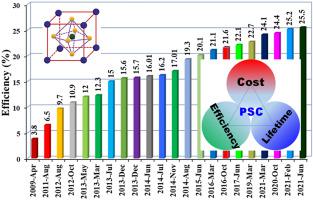Materials Today Physics ( IF 11.5 ) Pub Date : 2021-10-21 , DOI: 10.1016/j.mtphys.2021.100557 Muhammad Younas 1 , Tarek A. Kandiel 1, 2, 3 , Ali Rinaldi 1, 2 , Qing Peng 2, 3, 4 , Abdulaziz A. Al-Saadi 1, 5

|
A remarkable and fast development has been recently noticed in perovskite solar cells (PSCs). The efficiency of the emerging PCSs has been improved from 3.8% to 25.5% in only about one decade. The outstanding improvement in the performance of PSCs is attributed to perovskites' unique structural properties, high absorption coefficient, tunable band gap, long electron-hole diffusion length, and high charge carriers’ mobility. Efficient PSCs devices are normally fabricated at a lab scale in an inert environment with a very small area (∼0.1 cm2). However, for practical applications, there is a need to develop PSCs on a large-scale level in an ambient environment. Recently, enormous efforts have been devoted to design ambient-environment processable PSCs with considerable attention on understanding the impact of moisture and oxygen on their stability and efficiency. In this review, we start by shedding light on the main crystal and electronic properties of PSCs. We then focus on the recent progress in the ambient-environment processed PSCs and detailed the impact of moisture and oxygen on perovskite crystal growth, morphology, and stability. The possible approaches to control the fabrication of efficient and ambient stable perovskite solar cells have been discussed in detail. The available techniques for the development of PSCs at the lab scale with either controlled or ambient environments and at the large scale have been discussed and summarized. This review is finally concluded with a highlight of challenges encountered and pathways to improve the performance, stability, and scalability of PSCs before commercialization.
中文翻译:

环境处理钙钛矿太阳能电池:综述
最近注意到钙钛矿太阳能电池(PSC)取得了显着而快速的发展。新兴 PCS 的效率仅在大约十年内就从 3.8% 提高到 25.5%。PSCs 性能的显着改善归功于钙钛矿独特的结构特性、高吸收系数、可调带隙、长电子空穴扩散长度和高电荷载流子迁移率。高效的 PSC 器件通常在实验室规模的惰性环境中制造,面积非常小(~0.1 cm 2)。然而,对于实际应用,需要在周围环境中大规模开发 PSC。最近,在设计周围环境可加工 PSC 方面付出了巨大的努力,并非常关注了解水分和氧气对其稳定性和效率的影响。在这篇综述中,我们首先阐明 PSC 的主要晶体和电子特性。然后,我们关注周围环境处理 PSC 的最新进展,并详细说明水分和氧气对钙钛矿晶体生长、形态和稳定性的影响。已经详细讨论了控制高效和环境稳定钙钛矿太阳能电池制造的可能方法。已经讨论和总结了在受控环境或周围环境以及大规模实验室规模开发 PSC 的可用技术。这篇综述最后强调了在商业化之前遇到的挑战和提高 PSC 的性能、稳定性和可扩展性的途径。


























 京公网安备 11010802027423号
京公网安备 11010802027423号